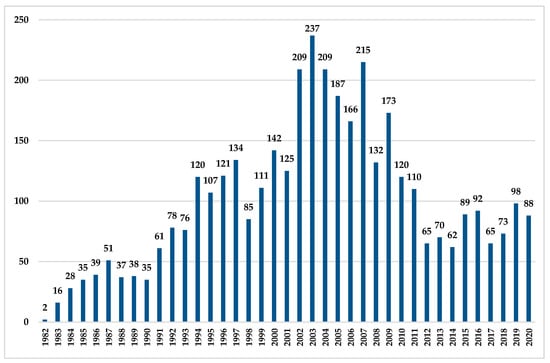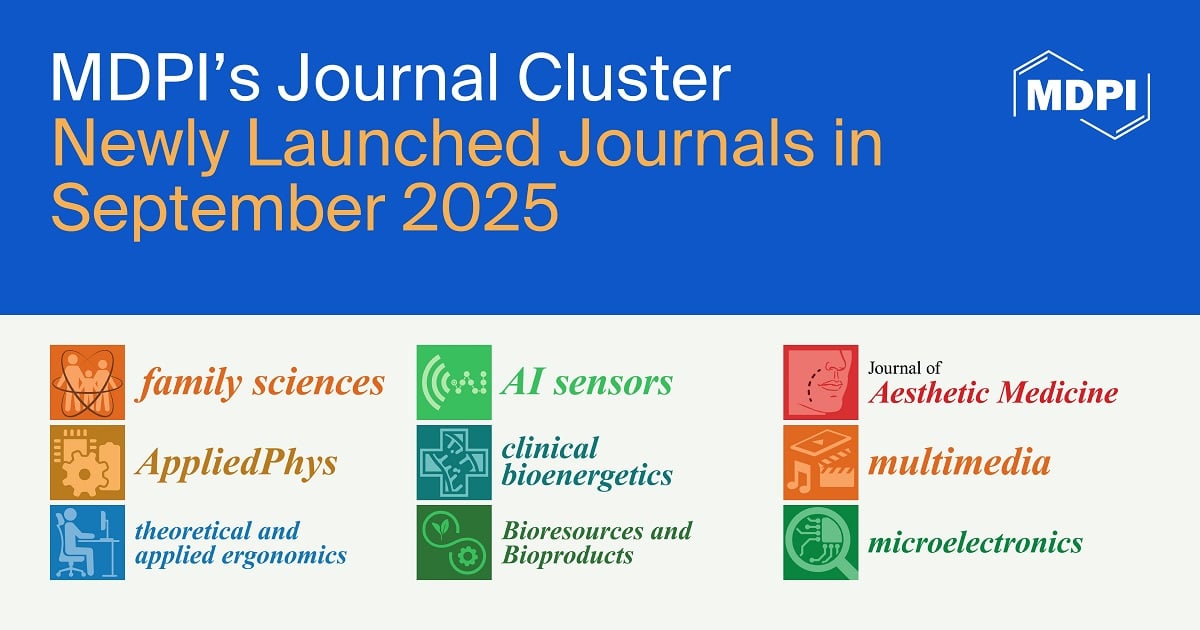Journal Description
Journal of Risk and Financial Management
Journal of Risk and Financial Management
is an international, peer-reviewed, open access journal on risk and financial management, published monthly online by MDPI.
- Open Access— free for readers, with article processing charges (APC) paid by authors or their institutions.
- High Visibility: indexed within Scopus, EconBiz, EconLit, RePEc, and other databases.
- Journal Rank: CiteScore - Q1 (Business, Management and Accounting (miscellaneous))
- Rapid Publication: manuscripts are peer-reviewed and a first decision is provided to authors approximately 20.5 days after submission; acceptance to publication is undertaken in 4.6 days (median values for papers published in this journal in the first half of 2025).
- Recognition of Reviewers: reviewers who provide timely, thorough peer-review reports receive vouchers entitling them to a discount on the APC of their next publication in any MDPI journal, in appreciation of the work done.
Latest Articles
Using Machine Learning to Detect Financial Statement Fraud: A Cross-Country Analysis Applied to Wirecard AG
J. Risk Financial Manag. 2025, 18(11), 605; https://doi.org/10.3390/jrfm18110605 (registering DOI) - 28 Oct 2025
Abstract
This study analyzes the ability of machine-learning algorithms to detect financial statement fraud using four financial ratios as inputs: the Altman Z-Score, Beneish M-Score, Montier C-Score, and Dechow F-Score. It also evaluates whether the Wirecard AG scandal of 2020 could have been detected
[...] Read more.
This study analyzes the ability of machine-learning algorithms to detect financial statement fraud using four financial ratios as inputs: the Altman Z-Score, Beneish M-Score, Montier C-Score, and Dechow F-Score. It also evaluates whether the Wirecard AG scandal of 2020 could have been detected by the model developed in this study. Financial statement data was obtained from the financial data vendor Bloomberg L.P. The dataset consists of 2,014,827 firm years between 1988–2019, from companies across the globe, of which 1145 firm years were identified as fraudulent. A balanced dataset of 1046 fraudulent firm years and 1046 randomly selected firm years was used to train and evaluate multiple machine-learning algorithms via an automated pipeline search. The selected model is an ensemble combining gradient boosting and k-nearest neighbors. On the held-out test set, it correctly classified 82.03% of the manipulated and 89.88% of the non-manipulated firm years, with an overall accuracy of 85.69%. Applied retrospectively to Wirecard AG, the model identified 7 of 17 firm years as fraudulent.
Full article
(This article belongs to the Special Issue AI and Emerging Technologies in Governance, Risk and Earnings Management)
►
Show Figures
Open AccessArticle
Balancing Shariah Authenticity and Market Stability: A Scenario-Based Framework for Implementing AAOIFI Shariah Standard No. 62 in the Global Sukuk Market
by
Tasawar Nawaz
J. Risk Financial Manag. 2025, 18(11), 604; https://doi.org/10.3390/jrfm18110604 (registering DOI) - 28 Oct 2025
Abstract
This work develops a scenario-based policy framework for the prospective implementation of AAOIFI Shariah Standard No. 62 in global sukuk markets. The analysis suggests that immediate, rigorous enforcement would advance Shariah authenticity yet risk near-term destabilisation: issuance could retrench, the pricing premia could
[...] Read more.
This work develops a scenario-based policy framework for the prospective implementation of AAOIFI Shariah Standard No. 62 in global sukuk markets. The analysis suggests that immediate, rigorous enforcement would advance Shariah authenticity yet risk near-term destabilisation: issuance could retrench, the pricing premia could widen, and the rating treatment could bifurcate or even become inapplicable for instruments with pronounced risk-sharing. By contrast, calibrated sequencing, targeted legal reforms to perfect title transfer, and harmonised supervisory guidance can mitigate fragmentation and sustain investor confidence while re-anchoring sukuk to their risk-sharing foundations. Taken together, aligning religious fidelity with market pragmatism is achievable: a measured adoption of Standard 62 can reinforce the ethical underpinnings of Islamic capital markets without compromising their capacity for resilient growth.
Full article
(This article belongs to the Section Economics and Finance)
►▼
Show Figures
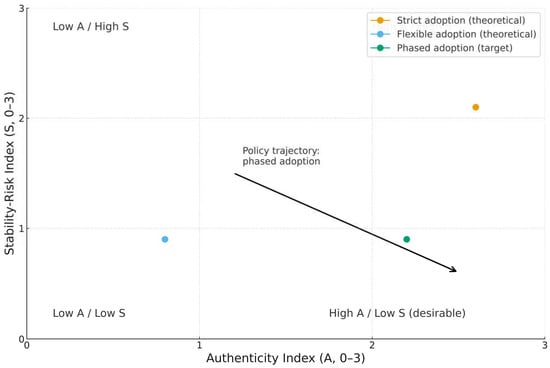
Figure 1
Open AccessArticle
Financing Rural Futures: Governance and Contextual Challenges of Village Fund Management in Underdeveloped Regions
by
Ari Warokka, Vetaroy Warokka and Aina Zatil Aqmar
J. Risk Financial Manag. 2025, 18(11), 603; https://doi.org/10.3390/jrfm18110603 (registering DOI) - 28 Oct 2025
Abstract
Effective management of village funds is central to financing sustainable and equitable rural futures, particularly in underdeveloped and resource-diverse regions such as Papua, Indonesia. This study explores the governance factors that shape the sustainability of village fund management (VFM) by examining institutional, financial,
[...] Read more.
Effective management of village funds is central to financing sustainable and equitable rural futures, particularly in underdeveloped and resource-diverse regions such as Papua, Indonesia. This study explores the governance factors that shape the sustainability of village fund management (VFM) by examining institutional, financial, and socio-cultural dimensions across 212 villages. Primary data from village heads and secondary data on village-owned enterprises (BUMDes) and 2024 village fund allocations were analyzed using exploratory factor analysis (EFA), partial least squares structural equation modeling (PLS-SEM), and multi-group analysis (MGA). Seven key governance constructs emerged, with ethical governance, implementation capacity, mandatory disclosure and reporting, community participation, and financial management capacity demonstrating significant positive effects on sustainable VFM outcomes. In contrast, perceived social and economic impacts were negatively associated with performance, and planning quality exerted an influence only under specific contextual conditions. These relationships proved highly context-dependent, varying by geography, natural resource availability, transport accessibility, and demographic composition. The findings underscore the need for adaptive and context-sensitive governance strategies to strengthen institutional resilience, enhance fiscal equity, and maximize the developmental impact of village funds in underdeveloped rural regions.
Full article
(This article belongs to the Section Applied Economics and Finance)
►▼
Show Figures
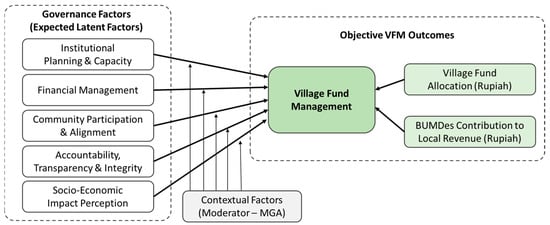
Figure 1
Open AccessArticle
The Influence of the Digital Accounting System on the Quality of Sustainable Decision-Making
by
Ahmed Almgrashi
J. Risk Financial Manag. 2025, 18(11), 602; https://doi.org/10.3390/jrfm18110602 (registering DOI) - 28 Oct 2025
Abstract
This study assesses De Lone and McLean’s Information System (D&M IS) Success Model concerning DAS throughout small and medium enterprises (SMEs) in Saudi Arabia (SA). The present work mainly sought to evaluate the impact of information quality (IQ), system quality (SysQ), service quality
[...] Read more.
This study assesses De Lone and McLean’s Information System (D&M IS) Success Model concerning DAS throughout small and medium enterprises (SMEs) in Saudi Arabia (SA). The present work mainly sought to evaluate the impact of information quality (IQ), system quality (SysQ), service quality (SrvQ) serving, system utilization, and user satisfaction (Usat) on the usage of the Digital Accounting System (DAS), which is posited to ultimately improve the quality of sustainable decision-making. The research utilized a quantitative methodology, employing a self-administered questionnaire to collect data from 328 decision-makers who are knowledgeable about actual DAS usage by SMEs in SA. Subsequent to gathering data, validation was conducted via Structural Equation Modeling (SEM) by utilizing smart-PLS software. The findings indicate that SysQ and IQ significantly influenced system utilization, although SrvQ did not. DAS was determined to significantly influence user happiness. Moreover, system utilization and user satisfaction positively influenced DAS, thereby affecting the sustainability of decision-making and reflecting the overall benefits of DAS. This work enhances the current IS literature by identifying the characteristics that affect the net advantages of DAS, with the suggested model evaluated in SMEs in SA utilizing DAS. This study serves as a reference to elucidate the significance of DAS and offers consequences, limitations, and prospects for further research.
Full article
(This article belongs to the Section Business and Entrepreneurship)
►▼
Show Figures

Figure 1
Open AccessReview
The Role of Artificial Intelligence in Improving the Efficiency and Accuracy of Local Government Financial Reporting: A Systematic Literature Review
by
Darmawati Darmawati, Noor Ismawati Jaafar, Rahmawati HS, Haniek Khoirunnissa Baja, Asharin Juwita Purisamya, Audrey Michelle Wenny Yolanda, Baso Amir and Muhammad Reza Pahlevi Juanda
J. Risk Financial Manag. 2025, 18(11), 601; https://doi.org/10.3390/jrfm18110601 (registering DOI) - 27 Oct 2025
Abstract
Digital transformation has driven the use of artificial intelligence (AI) in local government financial reporting to improve efficiency, transparency, and accountability. This study employs a systematic literature review (SLR) approach to analyze 20 relevant articles, identifying common characteristics of publications, research focus, methods,
[...] Read more.
Digital transformation has driven the use of artificial intelligence (AI) in local government financial reporting to improve efficiency, transparency, and accountability. This study employs a systematic literature review (SLR) approach to analyze 20 relevant articles, identifying common characteristics of publications, research focus, methods, AI technologies used, key findings, research gaps, and future research directions. The analysis results show the dominance of machine learning and expert systems in detecting fraud, predicting financial performance, and improving reporting accuracy. However, limitations in infrastructure, regulations, and system integration across government agencies remain significant challenges to implementing AI in the public sector. This study proposes the need for the development of practical implementation models, collaboration between academics, government, and technology developers, as well as the formulation of policies that support ethical and responsible AI governance. These findings make a significant contribution to shaping the strategic direction of AI utilization to strengthen local government financial reporting systems sustainably.
Full article
(This article belongs to the Special Issue Artificial Intelligence, Accounting, and Sustainability: Pathways to the SDGs)
►▼
Show Figures

Figure 1
Open AccessArticle
CEO Characteristics and Risk-Taking Behavior: Statistical Evidence from Saudi Arabia
by
Mahfod Aldoseri
J. Risk Financial Manag. 2025, 18(11), 600; https://doi.org/10.3390/jrfm18110600 (registering DOI) - 25 Oct 2025
Abstract
This paper aims to capture the impact of CEO characteristics on corporate risk-taking behavior in the emerging stock market, namely the Saudi market, by analyzing data from 43 firms listed in TADAWUL from 2016 to 2024 using a quantitative method through two statistical
[...] Read more.
This paper aims to capture the impact of CEO characteristics on corporate risk-taking behavior in the emerging stock market, namely the Saudi market, by analyzing data from 43 firms listed in TADAWUL from 2016 to 2024 using a quantitative method through two statistical models to examine how a CEO’s power, tenure, and confidence influence risk-taking behavior from accounting and market-wise perspectives. The results reveal that CEO power and CEO confidence show significantly positive coefficient impacts on market-wise corporate risk taking. In contrast, CEO tenure has no impact on market-wise corporate risk taking. In addition, CEO power and CEO confidence show an insignificant coefficient impact on accounting corporate risk taking. In contrast, CEO tenure has a significant N-shaped curve in accounting for corporate risk taking. The findings contribute to the existing accounting literature by providing new evidence from Saudi Arabia and provide insights into the influence of CEOs’ attributes in shaping a firm’s risk-taking behavior from two perspectives.
Full article
(This article belongs to the Topic The Future of Banking and Financial Risk Management)
Open AccessArticle
Non-Linear Impact of Environmental, Social, and Governance Scores on Deal Premiums
by
Ralph Sonenshine and Yan Wang
J. Risk Financial Manag. 2025, 18(11), 599; https://doi.org/10.3390/jrfm18110599 (registering DOI) - 24 Oct 2025
Abstract
Increasingly, scholars have been researching how ESG ratings appear to impact the returns of a merger as well as the expected synergies of the merger. This paper adds to the literature by using a non-linear method to test the impact that ESG ratings,
[...] Read more.
Increasingly, scholars have been researching how ESG ratings appear to impact the returns of a merger as well as the expected synergies of the merger. This paper adds to the literature by using a non-linear method to test the impact that ESG ratings, differences in ESG ratings between the acquirer and the target, and ESG components have on the deal premium. We find overwhelming evidence, using multiple deal premium measurements, of an inverted U-shaped relationship between the target’s ESG scores at the time of the announcement and the deal premium. Moreover, we find some evidence that differences between the ESG scores of the acquirer and the target also impact the deal premium but in a U-shaped relationship. Finally, our results show that the social scores of both the acquirer and the target impact the deal premium, again in an inverted U-shaped manner, as does the governance rating of target, but only in relatively smaller deals.
Full article
(This article belongs to the Special Issue Politics and Financial Markets)
►▼
Show Figures

Figure 1
Open AccessSystematic Review
Using Data Analytics in Financial Statement Fraud Detection and Prevention: A Systematic Review of Methods, Challenges, and Future Directions
by
Michail Gkegkas, Dimitrios Kydros and Michail Pazarskis
J. Risk Financial Manag. 2025, 18(11), 598; https://doi.org/10.3390/jrfm18110598 - 24 Oct 2025
Abstract
Reliable financial reporting is critical for maintaining market confidence and guiding stakeholders’ decision-making, yet traditional audit methods often fail to detect sophisticated fraud schemes that are hidden within large volumes of transactional data. This systematic literature review synthesizes 43 empirical and theoretical studies
[...] Read more.
Reliable financial reporting is critical for maintaining market confidence and guiding stakeholders’ decision-making, yet traditional audit methods often fail to detect sophisticated fraud schemes that are hidden within large volumes of transactional data. This systematic literature review synthesizes 43 empirical and theoretical studies published between 2010 and 2024 that utilize data analytics techniques for the prevention and detection of fraud in financial statements. Following the PRISMA guidelines, we conducted a four-phase review—identification, screening, eligibility assessment, and inclusion—to ensure transparency and reproducibility. Our analysis categorizes techniques into supervised machine learning classifiers (e.g., decision trees and neural networks), statistical anomaly detection methods, network-based analyses, and real-time monitoring frameworks. We evaluate each approach’s comparative effectiveness, highlight persistent challenges such as data imbalance, model interpretability, and governance constraints, and also trace evolving methodological trends over time. The review reveals that integrating predictive analytics and continuous monitoring into accounting information systems can transform audits from reactive investigations into proactive fraud prevention mechanisms. We conclude by proposing a future research agenda focusing on developing explainable AI models for audit applications, establishing robust data governance frameworks to support automated monitoring, and conducting longitudinal field studies to assess the real-world impact of analytics-driven controls.
Full article
(This article belongs to the Section Applied Economics and Finance)
►▼
Show Figures

Figure 1
Open AccessArticle
The Importance of Technological Progression in Impoverished Countries
by
Mohammed T. Hussein, Munir Quddus and Lawrence J. Trautman
J. Risk Financial Manag. 2025, 18(11), 597; https://doi.org/10.3390/jrfm18110597 - 24 Oct 2025
Abstract
In mid-2023, United Nations Secretary-General António Guterres warned that almost 80 years following the end of World War Two, “the global financial architecture is outdated, dysfunctional, and unjust. It is no longer capable of meeting the needs of the 21st-century world: a multipolar
[...] Read more.
In mid-2023, United Nations Secretary-General António Guterres warned that almost 80 years following the end of World War Two, “the global financial architecture is outdated, dysfunctional, and unjust. It is no longer capable of meeting the needs of the 21st-century world: a multipolar world characterized by deeply integrated economies and financial markets. But also marked by geopolitical tensions and growing systemic risks.” Further, the Secretary-General cautioned that “the current global financial system exacerbates inequalities, denying the poorest countries the credit and debt support they need and deserve”. We address the question: How does the transfer of modern technologies improve the economic development of impoverished nations? In this paper we demonstrate that rapid technological change is a double-edged sword—bringing significant productivity gains and economic progress while also causing profound societal disruptions and posing a threat of political instability in parts of the world. Nevertheless, we believe that a rapid and sustained transfer of these technologies holds great promise for the rapid development of today’s less developed nations.
Full article
(This article belongs to the Section Economics and Finance)
►▼
Show Figures

Figure 1
Open AccessArticle
Economic Policy Uncertainty, Geopolitical Risk, and the U.S.–China Relations: A Risk Transmission Perspective
by
Jacky Yuk-Chow So and Un Loi Lao
J. Risk Financial Manag. 2025, 18(11), 596; https://doi.org/10.3390/jrfm18110596 - 24 Oct 2025
Abstract
This study examines risk transmission between the United States and China using integrated economic policy uncertainty (EPU) and geopolitical risk (GPR) indices. We employ a dual methodology that combines Vector Autoregressive (VAR) and Granger causality in quantiles tests to analyze interactions during systemic
[...] Read more.
This study examines risk transmission between the United States and China using integrated economic policy uncertainty (EPU) and geopolitical risk (GPR) indices. We employ a dual methodology that combines Vector Autoregressive (VAR) and Granger causality in quantiles tests to analyze interactions during systemic leadership transitions, a dimension that is currently under-explored. Our dataset covers the period from June 2000 to June 2023. Results indicate that China is narrowing the economic influence gap and strengthening its role as a regional anchor. The U.S., however, maintains predominant global leadership. This dynamic reframes bilateral tensions as a “status dilemma” rather than a security conflict. Crucially, we identify asymmetric spillover effects: the U.S. uncertainty shocks spread globally, while China’s volatility remains regional. Our findings contribute to the understanding of financial stability by demonstrating that leadership asymmetries are critical determinants, providing valuable insights for designing systemic risk monitoring tools and contagion mitigation policies during periods of heightened uncertainty.
Full article
(This article belongs to the Section Applied Economics and Finance)
►▼
Show Figures

Figure A1
Open AccessArticle
Determinant Factor of Individual Taxpayer Compliance in Indonesia: Integrates of TPB Theory and Social Identity Theory
by
Nurhayati, Azhar Maksum, Narumondang B. Siregar and Fahmi Natigor Nasution
J. Risk Financial Manag. 2025, 18(11), 595; https://doi.org/10.3390/jrfm18110595 - 24 Oct 2025
Abstract
Studies on tax compliance have predominantly used the theory of planned behavior. This study combines the theory of planned behavior with social identity theory. This study examines tax fairness (subjective norms), tax complexity (perceived behavioral control), tax morality (attitudes toward behavior), and national
[...] Read more.
Studies on tax compliance have predominantly used the theory of planned behavior. This study combines the theory of planned behavior with social identity theory. This study examines tax fairness (subjective norms), tax complexity (perceived behavioral control), tax morality (attitudes toward behavior), and national pride as social identity theory that explain their impact on tax compliance levels. Using non-probability random sampling, this study successfully collected 401 individual taxpayer respondents and analyzed them using PLS-SEM. The results of this study revealed that national pride is a crucial component in improving taxpayer compliance behavior. TPB theory still makes a significant contribution to tax compliance intentions through tax fairness and tax morality. This research suggests that tax authorities should manage tax funds by providing a sense of fairness and improving taxpayer morality. On the one hand, the government needs to promote national pride among taxpayers. This has the potential to remind taxpayers of the presence of taxes and encourage the mobilization of funds from the tax sector for national development.
Full article
(This article belongs to the Section Business and Entrepreneurship)
►▼
Show Figures

Figure 1
Open AccessCommunication
GENIUS at Work in the US Financial System
by
Jimmie H. Lenz and Reid Tymcio
J. Risk Financial Manag. 2025, 18(11), 594; https://doi.org/10.3390/jrfm18110594 - 23 Oct 2025
Abstract
This paper examines the profitability of Stablecoin Issuance as regulated by the GENIUS Act. We provide an analysis of the revenues and expenses that can be expected to be earned and incurred by any regulated Stablecoin Issuer, as well as the competitive dynamics
[...] Read more.
This paper examines the profitability of Stablecoin Issuance as regulated by the GENIUS Act. We provide an analysis of the revenues and expenses that can be expected to be earned and incurred by any regulated Stablecoin Issuer, as well as the competitive dynamics at work in the industry. We argue that, since Issuers regularly pay a large portion of their reserve income to distributors, Issuer profitability is not a function of reserve yield but, rather, is determined by economies of scale and operational efficiencies. We also analyze the dynamics at work in the market for stablecoin distribution and conclude that US banks with brokerage subsidiaries are the firms most well-positioned to dominate both the issuance and distribution of stablecoins regulated under the GENIUS Act.
Full article
(This article belongs to the Section Banking and Finance)
►▼
Show Figures

Figure 1
Open AccessArticle
Systemic Risk Modeling with Expectile Regression Neural Network and Modified LASSO
by
Wisnowan Hendy Saputra, Dedy Dwi Prastyo and Kartika Fithriasari
J. Risk Financial Manag. 2025, 18(11), 593; https://doi.org/10.3390/jrfm18110593 - 22 Oct 2025
Abstract
Traditional risk models often fail to capture extreme losses in interconnected global stock markets. This study introduces a novel approach, Expectile Regression Neural Network with Modified LASSO regularization (ERNN-mLASSO), to model nonlinear systemic risk. By analyzing five major stock indices (JKSE, GSPC, GDAXI,
[...] Read more.
Traditional risk models often fail to capture extreme losses in interconnected global stock markets. This study introduces a novel approach, Expectile Regression Neural Network with Modified LASSO regularization (ERNN-mLASSO), to model nonlinear systemic risk. By analyzing five major stock indices (JKSE, GSPC, GDAXI, FTSE, N225), we identify distinct market roles: developed markets, such as the GSPC, act as risk spreaders, while emerging markets, like the JKSE, act as risk takers. Our network systemic risk index, SNRI, accurately captures systemic shocks during the COVID-19 crisis. More importantly, the model projects increasing global financial fragility through 2025, providing an early warning signal for policymakers and risk managers of potential future instability.
Full article
(This article belongs to the Special Issue Machine Learning, Economic Forecasting, and Financial Markets)
►▼
Show Figures

Figure 1
Open AccessArticle
The Nonlinear Effect of Financial Development on Income Inequality: New Evidence from a Multi-Dimensional Analysis
by
Zheng Li and Christos I. Giannikos
J. Risk Financial Manag. 2025, 18(10), 592; https://doi.org/10.3390/jrfm18100592 - 20 Oct 2025
Abstract
Over the past three decades, rising income inequality has undermined economic performance and posed challenges for policymakers, highlighting the need to identify its underlying drivers to design effective policy responses. Financial development is often considered a potential driver of inequality, yet the theoretical
[...] Read more.
Over the past three decades, rising income inequality has undermined economic performance and posed challenges for policymakers, highlighting the need to identify its underlying drivers to design effective policy responses. Financial development is often considered a potential driver of inequality, yet the theoretical and empirical literature on how financial development affects inequality remains inconclusive. Moreover, prior studies have primarily relied on traditional indicators, which do not comprehensively reflect the multidimensional nature of financial development. To address these gaps, we provide the first study to employ the IMF’s Financial Development Index and all its sub-indices within both fixed-effects and system GMM frameworks to examine whether financial development and its dimensions exhibit a nonlinear relationship with income inequality. Unlike traditional indicators, these indices offer a more comprehensive view of financial development. Using panel data for 130 countries from 1980 to 2019, we find that financial development and its dimensions—access to financial institutions (financial inclusion) and depth of financial institutions—initially reduce inequality but exacerbate it once their respective thresholds are exceeded. These results are not driven by systemic banking crises. Our study contributes by providing a more comprehensive assessment, demonstrating nonlinear effects, identifying thresholds, and offering policy implications for countries at different income levels.
Full article
(This article belongs to the Section Economics and Finance)
Open AccessArticle
Using Markov Chains and Entropy to Explain Value at Risk in European Electricity Markets
by
Oscar Walduin Orozco-Cerón, Orlando Joaqui-Barandica and Diego F. Manotas-Duque
J. Risk Financial Manag. 2025, 18(10), 591; https://doi.org/10.3390/jrfm18100591 - 20 Oct 2025
Abstract
The increasing complexity of energy systems amid the global push for decarbonization raises important questions about how transitions in the energy matrix affect financial risk in electricity markets. This study investigates the relationship between structural changes in national energy matrices and the systemic
[...] Read more.
The increasing complexity of energy systems amid the global push for decarbonization raises important questions about how transitions in the energy matrix affect financial risk in electricity markets. This study investigates the relationship between structural changes in national energy matrices and the systemic risk associated with electricity prices in Europe from 2015 to 2022. Using daily electricity price data, we calculate log returns and estimate the Value at Risk (VaR) at the 1% level as a measure of extreme financial loss. We incorporate energy market variables, including the volatility of Brent oil and coal prices, and an entropy-based indicator derived from the Shannon index, which captures the degree of technological dispersion in the energy mix over time. A fixed-effects panel regression model is applied across 21 European countries to identify the drivers of energy-related financial risk. Results show that higher volatility in Brent and coal prices significantly increases the VaR, and that greater entropy reflecting a more complex and dynamic energy transition also correlates with higher systemic risk. These findings suggest that while energy diversification is a goal of sustainability, it may entail short-term instability. The study contributes to the understanding of how structural transformations in energy systems interact with financial vulnerabilities in liberalized electricity markets.
Full article
(This article belongs to the Section Economics and Finance)
►▼
Show Figures

Figure 1
Open AccessArticle
Assessing the Early Impact of Industry 4.0 Technologies on the Activity, Efficiency, and Profitability of Croatian Micro-, Small-, and Medium-Sized Enterprises
by
Rajka Hrbić
J. Risk Financial Manag. 2025, 18(10), 590; https://doi.org/10.3390/jrfm18100590 - 17 Oct 2025
Abstract
This study examines the early impact of Industry 4.0 (I4.0) implementation on the financial performance of Croatian companies, focusing on indicators of profitability, efficiency, and activity. The research investigates whether firms adopting I4.0 technologies achieve superior results compared to traditional companies. A unique
[...] Read more.
This study examines the early impact of Industry 4.0 (I4.0) implementation on the financial performance of Croatian companies, focusing on indicators of profitability, efficiency, and activity. The research investigates whether firms adopting I4.0 technologies achieve superior results compared to traditional companies. A unique feature of this study is its integration of primary data—collected via an online survey of Croatian enterprises—with secondary data from publicly available financial reports. Statistical methods, including Analysis of Variance (ANOVA) and linear regression, were employed to test the hypotheses. The results show that I4.0 adopters perform significantly better in terms of net profit margin, return on assets, business efficiency, and supplier bonding days, while no significant difference was found in days sales outstanding. This paper contributes to the literature by offering one of the first empirical analyses of early-stage I4.0 adoption in the context of a transition economy, using firm-level financial data. The findings provide valuable insights for managers, policymakers, and investors aiming to understand the tangible business benefits of digital transformation. The results also highlight the importance of supporting I4.0 adoption strategies to enhance competitiveness and recovery in post-pandemic economic conditions.
Full article
(This article belongs to the Section Business and Entrepreneurship)
►▼
Show Figures

Figure 1
Open AccessArticle
How Does the Mauritanian Exchange Rate React During a Crisis? The Case of COVID-19
by
Mohamed Said Diah, Mohamedou Cheikh Tourad, Youssef Lamrani Alaoui, Mohamedade Farouk Nanne and Mohamed Abdallahi Beddi
J. Risk Financial Manag. 2025, 18(10), 589; https://doi.org/10.3390/jrfm18100589 - 17 Oct 2025
Abstract
This paper examines the impact of the COVID-19 pandemic on the volatility of the EUR/MRU and USD/MRU exchange rates using GARCH-type models. Symmetric GARCH(1,1) and asymmetric specifications—EGARCH and GJR-GARCH—are applied to capture potential leverage effects over two periods: pre-COVID (January 2017–December 2019) and
[...] Read more.
This paper examines the impact of the COVID-19 pandemic on the volatility of the EUR/MRU and USD/MRU exchange rates using GARCH-type models. Symmetric GARCH(1,1) and asymmetric specifications—EGARCH and GJR-GARCH—are applied to capture potential leverage effects over two periods: pre-COVID (January 2017–December 2019) and COVID (January 2017–December 2021). The results indicate that the pandemic increased short-run volatility for EUR/MRU, while its impact on USD/MRU was comparatively weaker. Asymmetric models reveal that COVID-19 altered the response of volatility to shocks, with EUR/MRU exhibiting heightened sensitivity and USD/MRU showing contrasting asymmetries. In addition, an out-of-sample backtesting exercise confirms the superior predictive performance of asymmetric models, particularly EGARCH for EUR/MRU and GJR-GARCH for USD/MRU. These findings underscore distinct volatility dynamics and the transmission of external shocks in a small open economy during periods of global uncertainty.
Full article
(This article belongs to the Section Financial Markets)
►▼
Show Figures
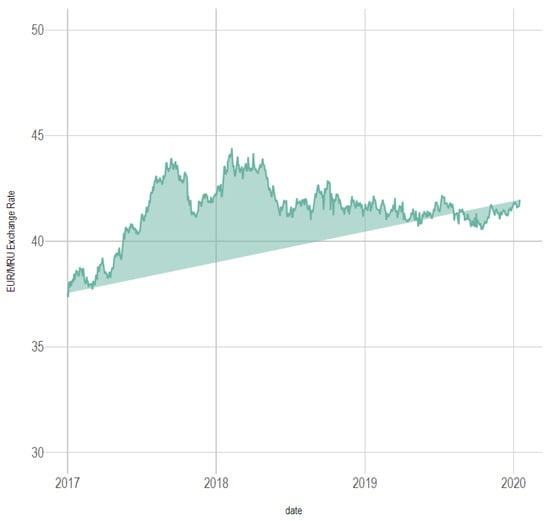
Figure 1
Open AccessArticle
Bias-Corrected Method of Moments Estimation of the Hurst Parameter for Improved Option Pricing Under the Fractional Black-Scholes Model
by
Hana Sagor, Edward L. Boone and Ryad Ghanam
J. Risk Financial Manag. 2025, 18(10), 588; https://doi.org/10.3390/jrfm18100588 - 16 Oct 2025
Abstract
The Hurst parameter H plays a critical role in modeling long-memory behavior in financial time series, particularly within the framework of the fractional Black–Scholes model (fBSM). While the Method of Moments (MOM) provides a fast, closed-form estimator for H, it suffers from
[...] Read more.
The Hurst parameter H plays a critical role in modeling long-memory behavior in financial time series, particularly within the framework of the fractional Black–Scholes model (fBSM). While the Method of Moments (MOM) provides a fast, closed-form estimator for H, it suffers from increasing negative bias, especially as H grows beyond 0.6. This paper proposes a bias-corrected version of the MOM estimator based on a quadratic regression fit derived from simulation data. The corrected estimator substantially reduces estimation error while retaining computational efficiency. Through extensive simulations, we quantify the impact of MOM bias on option pricing and demonstrate how our correction method leads to more accurate pricing under the fBSM. We apply the methodology to real financial assets—including Natural Gas, Apple, Gold, and Crude Oil—and show that the corrected Hurst estimates reduce option pricing error by up to USD 0.47 per contract relative to the uncorrected estimator, depending on the asset’s volatility structure. These results underscore the importance of accurate Hurst parameter estimation for derivative pricing, particularly in volatile markets such as energy and commodities, while also remaining relevant to equities and precious metals. The corrected estimator thus offers practitioners a simple yet effective tool to improve financial decision-making.
Full article
(This article belongs to the Section Mathematics and Finance)
►▼
Show Figures

Figure 1
Open AccessArticle
Market Reactions to Fintech M&A: Evidence from Event Study Analysis of Financial Institutions
by
Gimede Gigante, Lorenzo Galotta and Francesca Scarlini
J. Risk Financial Manag. 2025, 18(10), 587; https://doi.org/10.3390/jrfm18100587 - 16 Oct 2025
Abstract
The rise of fintech has disrupted traditional financial services, prompting banks and asset managers to respond strategically, often through mergers and acquisitions. This study investigates the short-term market reaction to M&A announcements involving fintech targets by incumbent financial institutions. Using an event study
[...] Read more.
The rise of fintech has disrupted traditional financial services, prompting banks and asset managers to respond strategically, often through mergers and acquisitions. This study investigates the short-term market reaction to M&A announcements involving fintech targets by incumbent financial institutions. Using an event study methodology centered on different event windows and cumulative abnormal returns computed via the market model, the analysis incorporates regression models with bidder-, deal-, and target-level variables to identify the drivers of performance. The results show that, on average, financial institutions experience negative abnormal returns around announcement dates, suggesting limited short-term value creation. Higher market-to-book ratios and tax rates are positively associated with CARs, while lower profit margins are linked to better market reactions. Subsample comparisons reveal that U.S. acquirers underperform their European peers, commercial banks fare worse than asset managers and investment banks, and pre-COVID-19 deals yield more favorable returns than post-COVID-19 ones. Robustness checks using different market benchmarks demonstrate that key patterns—especially those related to geography and timing—are sensitive to benchmark selection. Overall, this study highlights market skepticism toward fintech acquisitions by traditional financial institutions, particularly in specific contexts, and emphasizes the importance of controlling for structural factors when interpreting abnormal returns.
Full article
(This article belongs to the Section Business and Entrepreneurship)
►▼
Show Figures

Figure 1
Open AccessArticle
On Fintech and Financial Inclusion: Evidence from Qatar
by
Ashwaq Al-Sharshani, Fatma Al-Sharshani and Ali Malik
J. Risk Financial Manag. 2025, 18(10), 586; https://doi.org/10.3390/jrfm18100586 - 15 Oct 2025
Abstract
This study examines the role of fintech adoption in enhancing financial inclusion in Qatar, with a particular focus on the mediating influence of access barriers. A structured questionnaire was administered to 220 respondents, of which 200 valid responses were retained for analysis after
[...] Read more.
This study examines the role of fintech adoption in enhancing financial inclusion in Qatar, with a particular focus on the mediating influence of access barriers. A structured questionnaire was administered to 220 respondents, of which 200 valid responses were retained for analysis after screening for completeness and outliers. The constructs of fintech adoption (FA), financial inclusion (FI), and access barriers (AB) were measured using validated multi-item scales adapted from prior literature. Measurement reliability and validity were confirmed through Cronbach’s alpha, composite reliability, and average variance extracted (AVE), alongside confirmatory factor analysis (CFA) for construct validity. A structural equation modeling (SEM) approach was employed to test the hypothesized relationships, using maximum likelihood estimation with bootstrap standard errors and confidence intervals. Model fit indices indicated excellent fit (χ2 = 48.983, df = 51, p = 0.554; CFI = 1.000; TLI = 1.003; RMSEA = 0.000; SRMR = 0.036). Factor loadings were all significant (p < 0.001), supporting convergent validity. However, the structural paths from FA to FI (β = −0.020, p = 0.827), AB to FI (β = −0.077, p = 0.394), and FA to AB (β = 0.054, p = 0.527) were not significant. The indirect mediation effect of AB was also statistically insignificant (β = −0.004, p = 0.700).
Full article
(This article belongs to the Special Issue Behavioral Finance and Sustainable Green Investing)
►▼
Show Figures

Figure A1
Highly Accessed Articles
Latest Books
E-Mail Alert
News
Topics
Topic in
Clean Technol., Economies, FinTech, JRFM, Sustainability
Green Technology Innovation and Economic Growth
Topic Editors: David (Xuefeng) Shao, Miaomiao Tao, Selena ShengDeadline: 31 December 2025
Topic in
Economies, IJFS, JRFM, Risks, Sustainability
Insurance and Risk Management Advances in the 4A Era—AI, Aging, Abruptions, and Adoptions
Topic Editors: Xiaojun Shi, Lingyan Suo, Feng Gao, Baorui DuDeadline: 30 May 2026
Topic in
Economies, JRFM, Risks, Sustainability
The Future of Global Finance and Business: Trends, Policies and Market Evolution
Topic Editors: John Malindretos, Giuliana Andreopoulos, Ikechukwu Ndu, Eleftherios I. ThalassinosDeadline: 31 July 2026
Topic in
Economies, IJFS, Sustainability, Businesses, JRFM
Sustainable and Green Finance
Topic Editors: Otilia Manta, Maria PalazzoDeadline: 31 October 2026

Conferences
Special Issues
Special Issue in
JRFM
Environmental, Social, and Governance (ESG), Corporate Social Responsibility (CSR), and Green Finance
Guest Editor: Hok Ko PongDeadline: 30 October 2025
Special Issue in
JRFM
Innovations in Accounting Practices
Guest Editor: Yi LiuDeadline: 31 October 2025
Special Issue in
JRFM
Behavioral Finance and Financial Management
Guest Editor: Muhammad ArslanDeadline: 31 October 2025
Special Issue in
JRFM
Innovative Approaches to Managing Finance Risks in the FinTech Era
Guest Editor: Cunyi YangDeadline: 31 October 2025


